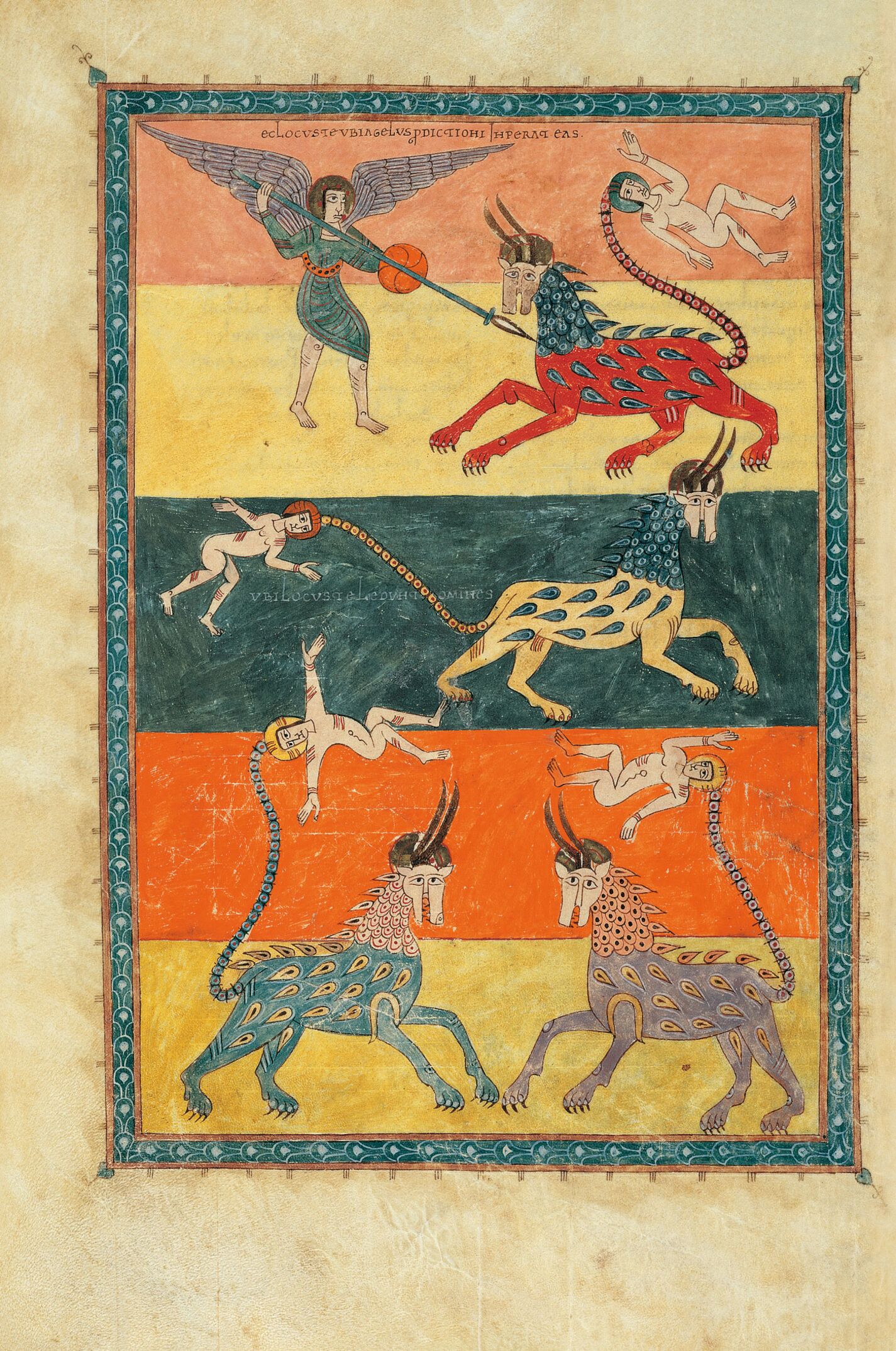This full-folio image shows, at the top, the angel of the abyss –beneath the legend “EC LOCVSTE VBI ANGELVS P[ER]DICTIONI INPERAT EAS”– Abbadon or Appolion, meaning destroyer but with no negative connotation, with a nimbus and his wings outstretched, clutching a small shield and brandishing a spear at one of the infernal locusts depicted in a totally different way from those appearing in the previous illustration. The locust now has the appearance of an anthropozoomorphic hybrid that does not abide exactly by the description in the storia. It has a circular, golden crown, horse’s ears and horns on its head; and the top half of its face is animal (equine) rather than human. The threatening creature is shown in profile with a horse’s body, albeit with feline paws and claws, covered in a mane or locks of hair, and a neck of stylised metal mesh reminiscent of iron cuirasses. Finally, it features a jointed tail similar to the one in the previous illustration which it drives into the haloed head of a naked man in an unnatural pose, but whose eyes are open thereby incurring in the same mistake as before. Depicted the length of the illustration are another three similar monsters, with bodies coloured differently from each other and the previous locust, tormenting another three men – those not marked with God’s sign – whilst the men with the sign are omitted. Two of these monsters are situated opposite each other in the bottom part and the one in the middle of the folio is alone, next to a legend reading “VBI LOCVSTE LEDVNT/OMINES”.
IIb manuscripts are very similar, varying basically as regards the configuration of the locusts, more in keeping with the storia in many respects, although only the Arroyo Beatus features the wings and is more organised and symmetrical. The only difference between the manuscripts in IIb and IIa is that, in the latter as in stemma I, the angel fights one of the monsters with just a spear whereas in IIb he also defends himself with a shield. Similarly, IIa usually features five locusts instead of four. The negative meaning of Abbadon is only obvious in the figure shown in profile and in the Phrygian cap, as we shall see later in relation to the Anti-Christ. This being could perhaps have originated in a misinterpretation of a staff of authority, which was transformed, even in European versions, into a spear with which he controlled the locusts as if he were their king, as can be seen in the Saint-Sever Beatus (f. 145v), making use of another commentary, such as the one by Tyconius, to create this image.
Carlos Miranda García-Tejedor
Doctor in History
(Fragment of the Girona Beatus commentary volume)

This full-folio image shows, at the top, the angel of the abyss –beneath the legend “EC LOCVSTE VBI ANGELVS P[ER]DICTIONI INPERAT EAS”– Abbadon or Appolion, meaning destroyer but with no negative connotation, with a nimbus and his wings outstretched, clutching a small shield and brandishing a spear at one of the infernal locusts depicted in a totally different way from those appearing in the previous illustration. The locust now has the appearance of an anthropozoomorphic hybrid that does not abide exactly by the description in the storia. It has a circular, golden crown, horse’s ears and horns on its head; and the top half of its face is animal (equine) rather than human. The threatening creature is shown in profile with a horse’s body, albeit with feline paws and claws, covered in a mane or locks of hair, and a neck of stylised metal mesh reminiscent of iron cuirasses. Finally, it features a jointed tail similar to the one in the previous illustration which it drives into the haloed head of a naked man in an unnatural pose, but whose eyes are open thereby incurring in the same mistake as before. Depicted the length of the illustration are another three similar monsters, with bodies coloured differently from each other and the previous locust, tormenting another three men – those not marked with God’s sign – whilst the men with the sign are omitted. Two of these monsters are situated opposite each other in the bottom part and the one in the middle of the folio is alone, next to a legend reading “VBI LOCVSTE LEDVNT/OMINES”.
IIb manuscripts are very similar, varying basically as regards the configuration of the locusts, more in keeping with the storia in many respects, although only the Arroyo Beatus features the wings and is more organised and symmetrical. The only difference between the manuscripts in IIb and IIa is that, in the latter as in stemma I, the angel fights one of the monsters with just a spear whereas in IIb he also defends himself with a shield. Similarly, IIa usually features five locusts instead of four. The negative meaning of Abbadon is only obvious in the figure shown in profile and in the Phrygian cap, as we shall see later in relation to the Anti-Christ. This being could perhaps have originated in a misinterpretation of a staff of authority, which was transformed, even in European versions, into a spear with which he controlled the locusts as if he were their king, as can be seen in the Saint-Sever Beatus (f. 145v), making use of another commentary, such as the one by Tyconius, to create this image.
Carlos Miranda García-Tejedor
Doctor in History
(Fragment of the Girona Beatus commentary volume)